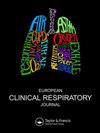Agreement between reported questionnaire data and medical records on diagnosis and COVID-19 symptoms at onset
IF 1.4
Q3 RESPIRATORY SYSTEM
引用次数: 0
Abstract
ABSTRACT The aim of this study was to assess whether there was agreement between self-reported data in a survey and medical records regarding diagnoses and symptoms at COVID-19 onset. The impact of sociodemographic factors on agreement between the two data sources was also assessed. Cross-sectional data were extracted from a Swedish longitudinal cohort study. In total, 401 non-hospitalized patients with a polymerase chain reaction-confirmed COVID-19 infection responded to a survey and agreed to a review of their electronic medical records. Agreement, estimated using the kappa statistic, sensitivity, and specificity were calculated for nine diagnoses and eleven symptoms. Differences between subgroups based on sociodemographic factors were assessed. The agreement between the self-reported data and medical records was at a substantial to moderate level for diagnoses such as diabetes mellitus (kappa 0.65, sensitivity 86%) and hypertension (kappa 0.59, sensitivity 56%) and at a fair level for more difficult-to-define conditions such as ongoing immunosuppressive treatment (kappa 0.27, sensitivity 25%). The agreement between the two data sources on symptoms was between fair and poor (kappa 0.36 for fever; kappa 0.05 for fatigue). Agreement for some diagnoses and symptoms varied across some sociodemographic subgroups, e.g. agreement in diabetes mellitus was significantly better in males (kappa 1.0) than females (kappa 0.52, homogeneity tests p = 0.02). In general, kappa values were lower for symptoms than diagnoses. The agreement between the two sources varied with diagnoses and symptoms and was also influenced by sociodemographic factors. This study illustrates that it is important to consider type of data used in the epidemiological studies as different information sources differ with quality and accuracy.所报告的问卷数据与医疗记录中的诊断和 COVID-19 发病症状之间的一致性
摘要 本研究旨在评估一项调查中的自我报告数据与 COVID-19 发病时的诊断和症状方面的医疗记录是否一致。此外,还评估了社会人口因素对两种数据来源之间一致性的影响。横断面数据来自瑞典的一项纵向队列研究。共有 401 名经聚合酶链反应确诊感染 COVID-19 的非住院患者接受了调查,并同意查阅其电子病历。针对九种诊断和十一种症状计算了卡帕统计估计的一致性、敏感性和特异性。评估了基于社会人口学因素的亚组之间的差异。在糖尿病(kappa 0.65,灵敏度 86%)和高血压(kappa 0.59,灵敏度 56%)等诊断方面,自我报告数据与医疗记录之间的一致性达到了相当高到中等的水平,而在较难界定的病症方面,如正在进行的免疫抑制治疗(kappa 0.27,灵敏度 25%),两者之间的一致性达到了一般水平。两个数据源在症状方面的一致性介于一般和较差之间(发热的 kappa 值为 0.36;疲劳的 kappa 值为 0.05)。在一些社会人口亚群中,某些诊断和症状的一致性存在差异,例如,男性在糖尿病方面的一致性(kappa 1.0)明显优于女性(kappa 0.52,同质性检验 p = 0.02)。一般来说,症状的 kappa 值低于诊断的 kappa 值。两种来源的一致性因诊断和症状而异,也受社会人口因素的影响。这项研究表明,考虑流行病学研究中使用的数据类型非常重要,因为不同的信息来源在质量和准确性方面存在差异。
本文章由计算机程序翻译,如有差异,请以英文原文为准。
求助全文
约1分钟内获得全文
求助全文
来源期刊

European Clinical Respiratory Journal
RESPIRATORY SYSTEM-
CiteScore
3.80
自引率
0.00%
发文量
15
审稿时长
16 weeks
 求助内容:
求助内容: 应助结果提醒方式:
应助结果提醒方式:


